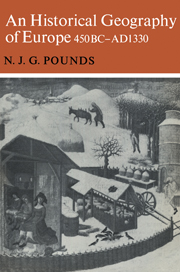6 - Europe in the early fourteenth century
Published online by Cambridge University Press: 05 June 2012
Summary
By the end of the first quarter of the fourteenth century the period of medieval economic growth was over, and with it the cultural flowering to which it had given rise. The late medieval population decline had not yet begun, or, at least, had not reached measurable proportions. But there had been a run of bad harvests a few years before, and mortality had been heavy. Most medieval cities had already achieved their maximum size, as measured by the circuit of their walls. The great cathedrals and churches were built, and the few that still lay unfinished were to remain so into modem times. It is the Europe of this late summer of the Middle Ages that this chapter seeks to describe.
POLITICAL GEOGRAPHY
By the fourteenth century the political map of Europe had begun to assume the form which it was to retain for several centuries. In the west and north the national monarchies had taken shape. In the east, the tribal kingdoms of Poland, Bohemia, Hungary, Serbia and Bulgaria had ripened into states with well-defined boundaries and established administrative structures. Only within the limits of the German Empire was the trend towards the centralisation of political power reversed, with the fragmentation of the German Empire into an immense number of quasi-sovereign territories and self-governing cities. In Italy, too, where the imperial authority had rarely been more than nominal, the land was breaking up into independent duchies and contadi, while the Balkan peninsula had already become the prey of plundering bands of Crusaders from the west and of Turkish armies from the east.
- Type
- Chapter
- Information
- An Historical Geography of Europe 450 B.C.–A.D. 1330 , pp. 313 - 433Publisher: Cambridge University PressPrint publication year: 1973



